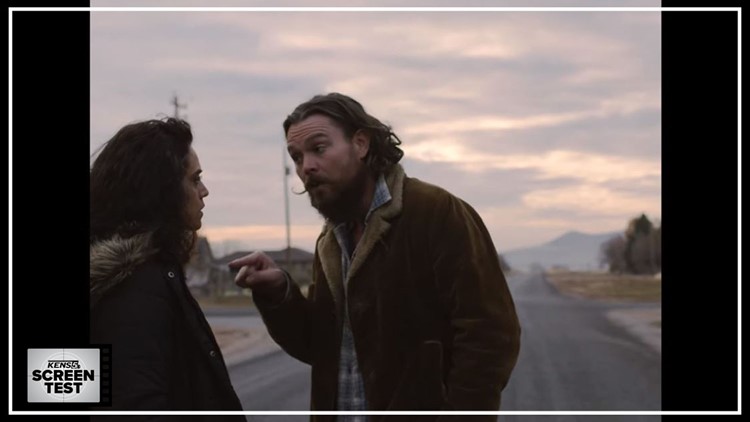Three opening shots – a bearded man barely restraining his emotions, another man and a woman sleeping in a bed, and the shaky pointing of a gun – is all filmmaker Robert Machoian needs to drop anchor in “The Killing of Two Lovers,” a quietly bruising character study which serves as a reminder about how visceral even an 85-minute, conversations-driven drama unfolding in a rural town seemingly left behind by the world around it can still be in 2021. Such as it is, while Machoian’s remarkably gripping feature isn’t destined to attract the same attention as the zombie-centric blockbusters and Hitcockian thrillers releasing this weekend, it boasts as much style as those genre offerings—even though it can be as muted as a cold breeze blowing across western plains, it ensnares us into a familial dynamic where simple binaries like right and wrong, lies and truths, don’t exist. It’s one of the thorniest relationship dramas since “Blue Valentine.”
Who is this man and who’s in the bed? The answers will come easier than the answer to another, more complicated question: What’s making him so hesitant to pull the trigger now that he’s arrived, to the point that he sneaks out the window without doing so? A substantial portion of the breath-catching power of “The Killing of Two Lovers” resides in the mesmerizing unfurling of its web of characters, but I feel comfortable enough with at least saying the man is David (Clayne Crawford, as dynamic as his long resume would suggest), and he’s at a crossroads in his marriage to Sepideh Moafi’s Nikki.
It remains ambiguous how David and Nikki found themselves on rocky terrain, but the film’s craggy pathos is no less complicated for us to navigate; though they might have once said in rosier times that they would move mountains for each other, it says plenty that those gloomy peaks continue to loom in the background. At the moment we join their story, David and Nikki are in separate households – him with his dad, her at their house with their four kids – but the “distance” hurts more than it helps seeing as a short stroll would cover it. While the closeness makes it easy for David when he comes to pick up the kids, it becomes a cruel torment for him to know Nikki is spending some of their time in marital limbo by seeing someone else. The emotional claustrophobia is deftly emphasized into a slow-burn symphony of the movie’s uniformly excellent elements. Crawford’s heartbreakingly anguished performance, cinematographer Oscar Ignaco Jimenez’s unbroken and impressively engrossing shots, a discordant soundscape in which the rattle of a truck engine melts uneasily into an ambient cocking of a pistol’s hammer—Machoian utilizes his arsenal for maximum unpredictability in a movie with familiar narrative contours.
What supplies the film with its vitality are the various perspectives with their own stake to claim. As each interpersonal strand between David, Nikki, their family and this tiny town gets untangled, a messy dynamic gets even messier. That’s the compromise Machoian asks of his audience, and one we couldn’t prevent ourselves from being knotted into if we tried. If three shots is all the writer-director needs to establish an impression, give him a half-hour more and he has us invested in the outcome of every outburst, leaning in a little closer so we can make out every muted bit of dialogue being uttered in the distance.
It’s a marvel that the filmmaker is able to convey what’s at stake without outright showing us, but herein lies the genius of Machoian’s approach. The movie’s stripped-down, ultrafocused ethos means its vast spaces – both literal and emotional – aren’t just empty, but missing something that filled them before, whether it be love between a husband and wife or a fulfilling connection between a father and his children. It might not be the first time their oldest teenage daughter tried to skip out on school when David spots her on the side of the road one morning, but the suspenseful staging and performances of that scene underscore how the family’s fraught situation has seeped into every decision, big or small. Undercurrents of history run through every interaction, briefly popping up to rear their head in moments of unvarnished intimacy, such as when Nikki gently nudges David to sing her one of his new songs he hopes to perform with his band soon.
It’s a soft lullaby of longing and regret, and the way the vulnerability transitions into a quiet annoyance and then full-blown frustration is indicative of how the past tends to catch up all too quickly with the volatility of the present between two lovers. Restraint is being tested at all times here, and that’s just as true for the filmmaking as it is for David. That the film begins with the match pressed firmly against the side of the matchbox is an indication not just of the striking boldness with which Machoian will tell this story, but of his understanding that the most inviting narratives stretch far beyond a film’s opening studio logos and closing credits. What awaits within that space in “The Killing of Two Lovers” are tense confrontations, piercingly beautiful writing and a purposeful sense of isolated place—all of which is informed, disfigured, corrupted and enlightened to some degree by the film’s first minute.
Does our one-sided knowledge about what David came so close to doing mean we should be rooting against him, and by proxy the stability of this family? Does that evidence of passion, even passion nearly corrupted into irreversible violence, justify the movie-watcher’s primal desire that he and Nikki will amend whatever cracks they can’t seem to pinpoint? By foregrounding the story in a place of such emotional cataclysm, we spend every minute which comes after hoping against hope that these participants in the most unmaneuverable game of marital dysfunction emerge with only first-degree burns. Where “The Killing of Two Lovers” goes makes us wonder if that pain is actually the proof of feeling they’ve been desperately searching for.
"The Killing of Two Lovers" is rated R for language. It's now available in some theaters and on VOD platforms.
Starring: Clayne Crawford, Sepideh Moafi, Chris Coy, Avery Pizzuto
Directed by Robert Machoian
2021
MORE REVIEWS:
- ‘The Woman in the Window’ Review: Delayed Netflix thriller struggles to conjure intrigue worthy of its Hitchcockian flourishes
- 'Wrath of Man' Review: Guy Ritchie underestimates his own star and story in needlessly messy crime thriller
- ‘Undergods’ Review: An ill-shapen diorama about the ills of capitalism
- ‘The Paper Tigers’ Review: Martial arts flick struggles to balance heart and humor amid flecks of personality
- ‘The Mitchells vs. the Machines’ Review: A deliriously fun road trip to the end of the world
- ‘Nomadland’ Review: Frances McDormand ventures west in a lament and tender celebration of America’s final frontiers
- ‘Together Together’ Review: Patti Harrison submits a star-making turn opposite Ed Helms in a different kind of rom-com



